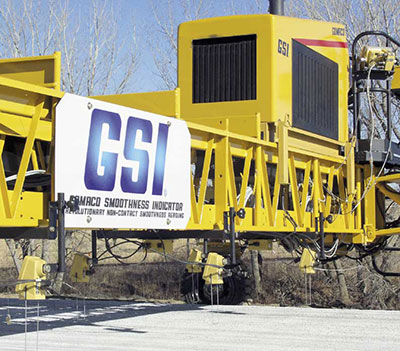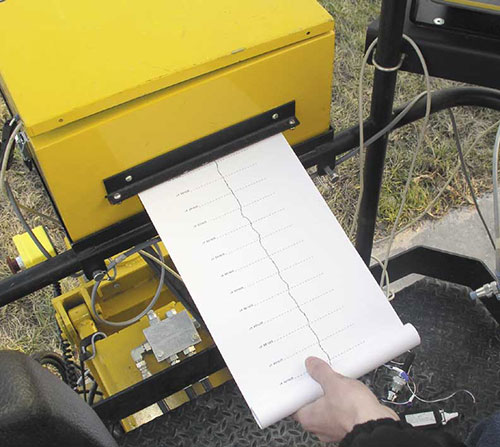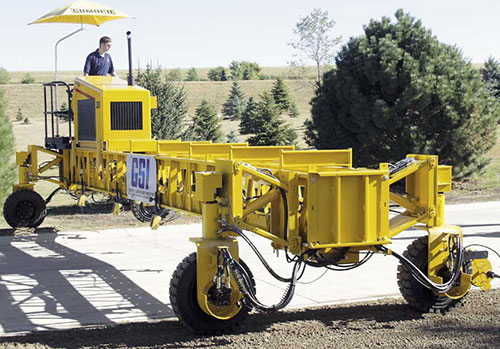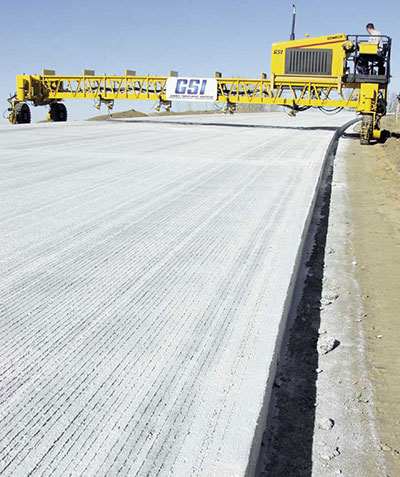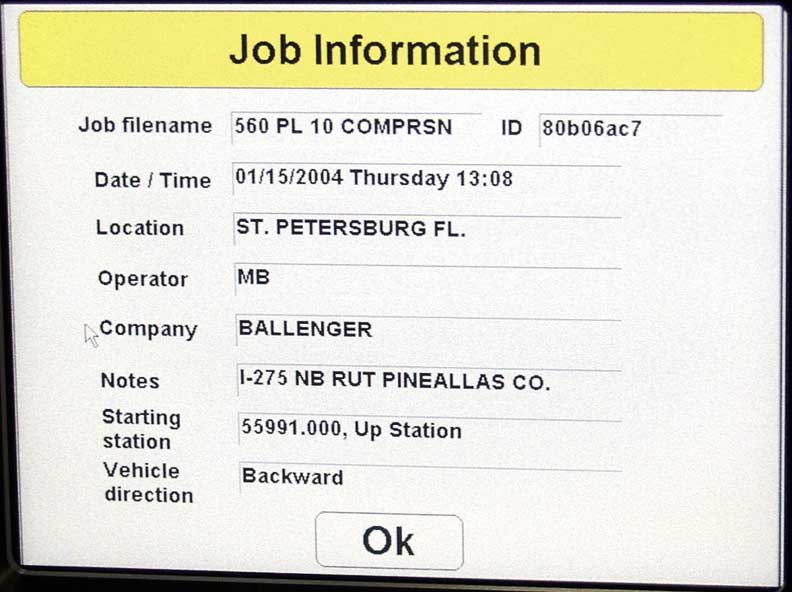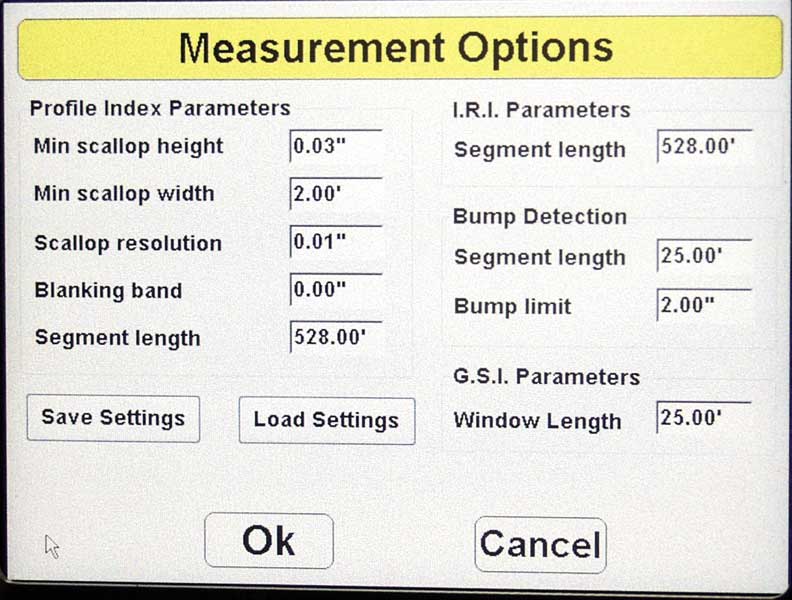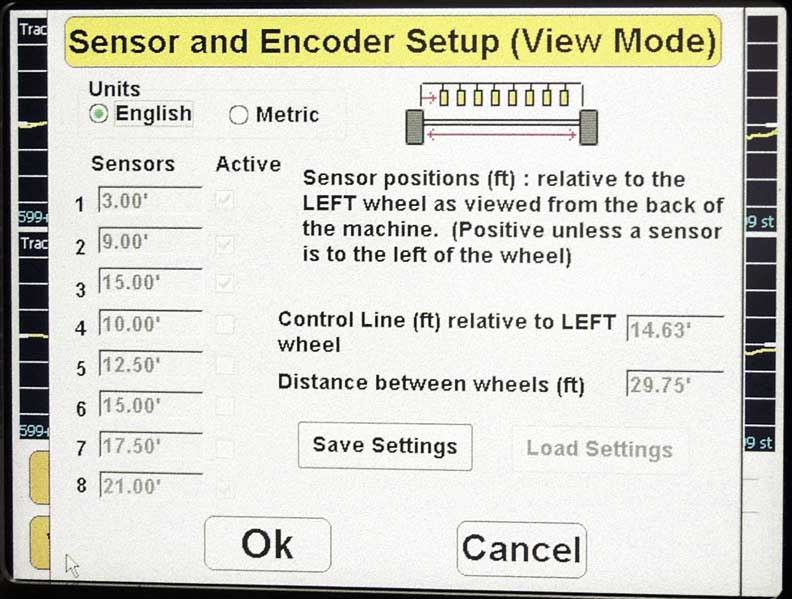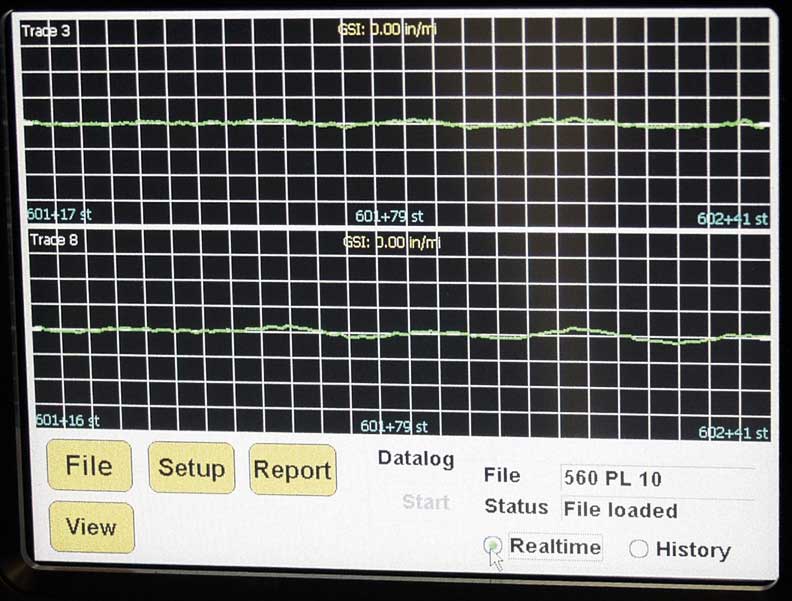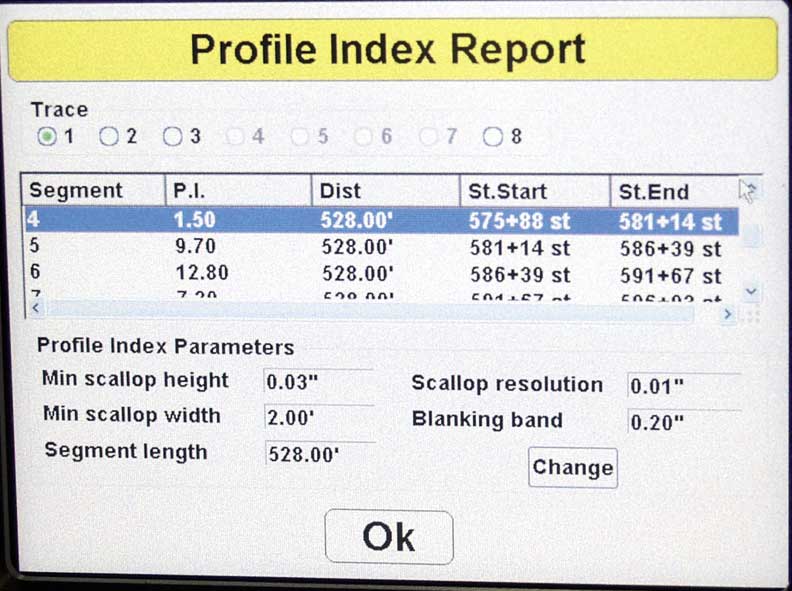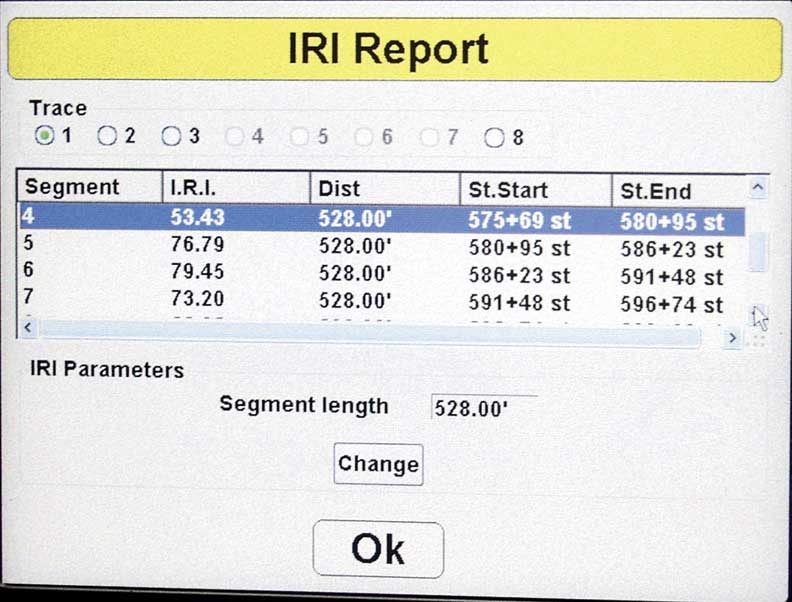GOMACO World Index --- GOMACO World 32.1 - February 2004
GOMACO's Non-Contact Profile Device – The GSI®
Both sonic and slope sensors mounted to the GSI’s frame take readings simultaneously to determine pavement smoothness.
A GOMACO World interview with Kevin Klein, research and development manager, and Mark Brenner, research and development control designs engineer
What is the GOMACO Smoothness Indicator (GSI)?
Klein: It's a non-contact profile device which can be used to develop profilographs for several different types of road surfaces. Actually, there are several ways to use it, some that we don't even know about right now.
How do you set up and operate the GSI?
Klein: Every step of the way we've tried to make it easy to operate and user friendly. Most of the technology is in the software. All of the machine components are "off the shelf items," but the software is unique. As far as set up, at the beginning of the project, the sensors and components have to be mounted onto the GSI machine or on the paver itself. It's not necessary to have the GSI printer on board at all times because you can collect data and print it out at a later time. There are a couple of calibration steps that need to be done for initial setup to calibrate the encoders or the pulse pickups in the motors. This calibrates the distance measuring devices that are on the machine. You drive the machine a known distance and then enter that distance into the GSI computer.
Brenner: You push start on the touch screen, run your machine the specified distance, stop, and then enter the exact length that you traveled. The distance traveled doesn't matter. If you went 105 feet (32 m) and overshot your 100 feet (30.5 m) line, you don't have to start over. You simply type in 105 feet (32 m) and it will calibrate to that measurement.
Klein: The next thing in setup is to enter the job-site information into the computer: highway number, direction of travel, job, contractor, city, state, etc. Then you're ready to run.
How do the sensors know where they are on the frame and what they're measuring? Do they refer back to the left wheel track?
Brenner: Actually the sensors don't need to know, the GSI computer needs to know where the sensors are located in relationship to the wheels on each end of the frame. You have to input a measurement that is the distance between the two wheels because there's an encoder or PPU mounted at each end on the wheel. You then input distance measurements for each set of instruments from your left wheel. The GSI computer then knows where each sensor is, based on these recorded measurements. For example on a radius... the sensor on the inside radius will have a shorter distance of travel than the one on the outside radius. It all refers back to the left wheel track.
Are you measuring the slab in the wheel path all the time?
Klein: No, sometimes specifications call for quarter traces, but to our understanding, measuring the wheel trace is the most common. It all depends on the state's specifications.
What is the minimum amount of equipment involved?
Klein: To do a single trace, you would need what we are considering a single trace GSI unit. The unit includes the GSI computer, two sonic sensors, a slope sensor, and all the mounting hardware and cables. If you are mounting on a paver, you're also going to need two encoders, one for each side.
Brenner: There's also a CAN Gateway.
Klein: In fact, on the GSI machine, there are actually two CAN Networks, one for the GSI and one for the machine control. They're both on the same machine, but they don't communicate with each other.
Can it be mounted to an ATV?
Klein: Correct, assuming that you can get the ATV to travel at steady speeds less than 80 fpm (24.4 mpm).
What kind of reports can you output from the information you collect from the GSI?
Brenner: There are three indexes being calculated continually as the machine collects data. The GSI index, PI or profile index, which is based on the California profilograph and the IRI (International Roughness Index). You can also export an .erd file, which is currently used for IRI traces.
Klein: They are all derived from the true profile of the surface, determined by the data we are collecting. Those three happen all the time, the way the system is set up now.
Brenner: External of the system, we can export the file and use it to analyze all other types of indexes off the true profile. If you can create a true profile, you can create any index required.
How do you identify where your bumps are located?
Klein: Both through the printed report or by calling up the run on the GSI computer monitor. Each shows the measured distance and where exactly the bump is located.
Is there any way to alter the data to take out a bump?
Klein: It's almost impossible. We're taking measurements every two inches (51 mm), even though we're getting readings 40 times per second, as the machine indexes forward. We're collecting large amounts of data to develop this profile. I don't think there's any way that the data could be altered. There are too many things that are related to the job site to accomplish that.
Is there an on-the-go bump alarm?
Klein: Yes, right now, a screen comes up with a warning window that says "bump" and you can go from there to look at where the bump is. We have an output for an external component like a buzzer or a light that we can drive from the computer.
Brenner: There are three bump alarm options. One is the external output, one is a pop-up screen and the other is an external warning without the window popping up on the computer screen.
After you've fixed your bump and re-run your GSI over that area again, does it make a separate script so you can see the improvements you've made?
Brenner: It saves over the file that you've just previously done.
Klein: We're developing a way to store that original bump data someplace else. Right now, if the machine moves forward, it counts so many feet. It knows and keeps track of the distance it's traveled. If it starts backing up, it starts deducting from that number.
Has the GSI been tested for accuracy?
Brenner: We've tested against proven manual profilograph machines that are out there. We have good output or graphs compared to those machines that are qualified by different states. We also had very good repeatability.
How do you justify the expense of the GSI to a contractor?
Klein: First of all, if it helps him improve his process where he can avoid expensive grinding, I think that's probably going to be a big selling feature or reason to buy. There are also the other applications the GSI makes possible to help his operation: reading the grade ahead of the paver, checking the stringline setup, checking the ride... We also had discussions about being able to develop or determine the volume of concrete it's going to take to do the job based on the grade that is already in place. It's a big issue for subcontractors where the prime contractor is getting the grade ready. If the subcontractor comes in and paves it and the prime has undercut the grade, it costs more for the concrete. We could develop a program where they'd be able to do a run first with the GSI machine, read the grade, and be able to determine what volume of concrete it will take to bring it up to the right elevation for the slab. They could then go to the prime and say the GSI is showing a 10 percent overrun and be able to ask the prime if they want to fix the grade or go ahead and pave. They could make that decision from information supplied by the GSI.
What does the future hold for the GSI? Do you see every mainline paving contractor owning one?
Klein: Absolutely. Not only is the market going to be targeted towards contractors, but there are a lot of other possibilities out there. There are engineering firms, Department of Transportations, Federal highway authorities, and others. We are anxious for the GSI to be certified for accuracy by the states. We believe that the GSI index could become a norm. Instead of having to convert all the information to a California profilograph or an IRI, it's a possibility that the GSI index would be all that's necessary. I think the GSI's future is looking bright with its non-contact versatility.
The GSI is very versatile. It's not just limited to concrete paving.
Klein: Exactly. You can read asphalt slabs, flooring, the stringline, you can read the grade, the pavement behind the paver, behind the finishers, behind the texture/cure machine, two days later... I still believe it's going to teach us a lot about different mix designs for concrete paving and how those mix designs cure and what their curing process does to the ride. It may be a great ride coming out of the paver, but two days later after it's all cured out, there might be bumps showing up because of the way that concrete cured. There may be some concrete mix designs that cure more favorably than others.
Is the accuracy of the machine affected by the fact that it runs on the grade and not on the finished slab?
Klein: The machine is designed to run on any surface, within reason. You can't travel over two foot (0.6 m) rocks or extreme grades. It will give you a trace without worrying about what the machine frame is doing. That was one of the goals or parameters that we set from the very beginning. We had to be able to get this trace with the GSI independent of what the machine was running over. We knew from the very beginning that we had to develop something that would measure everything electronically and establish an imaginary baseline through the software.
Brenner: The machine can go over a fairly rough terrain without interfering with the data that the GSI collects from the slab. The variations in the frame during travel are eliminated in the software by the "two sonic sensor and a slope sensor" unit.
So far, you've worked with a couple of contractors. What have their reactions been so far?
Klein: I think they'd say they're excited about the future possibilities and they're definitely very interested in the concept. They're intrigued by the non-contact concept and the time savings by doing up to eight traces in a single pass.
Subscribe to Receive GOMACO World Magazine
